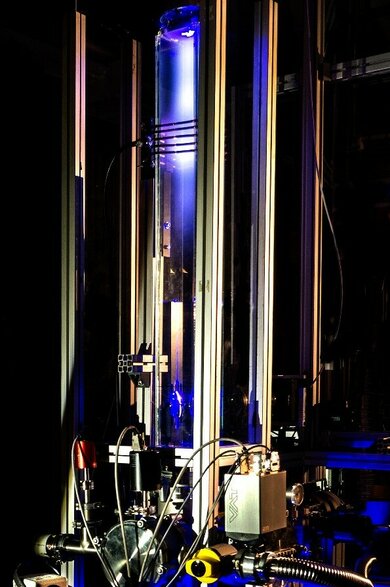Researcher in the Spotlight: Boy van Minderhout
Plasma assisted contamination control for ultra-clean vacuum systems

"Hello, I’m Boy van Minderhout in the Elementary Processes in Gas Discharges research group at the Department of Applied Physics and my research focuses on the plasma assisted contamination control for ultra-clean vacuum systems. For many high-tech applications such as high precision production, lithography, electron microscopy and nuclear fusion, nano- to micrometer sized particle contamination is becoming an increasingly significant problem. Not only can particles contaminate delicate surfaces, also gas flows can be polluted by them. Both kinds of particle contamination can be controlled using ionized gases, named plasmas."
Need for deeper knowledge
"Plasmas, consisting of particles such as free electrons, ions and atoms, are able to electrically charge particles of any kind. Utilizing this complex but interesting phenomenon of plasma-charging, the path of particles can eventually be controlled using electric and/or magnetic fields, either externally applied or induced by the plasma itself. To develop applications based on this concept further, there is an urgent need for deeper knowledge about the charging dynamics when these particles enter and leave a plasma region."
"With an eye on a wide range of applications, we are focusing more than ever on the field of Complex Plasmas, i.e. the interaction between fine particles and plasmas. Many of these research projects are (partly) funded by high-tech industrial partners and this is exemplified by our research project enabling the development of plasma assisted contamination control for ultra-clean vacuum systems. It also highlights the strong collaboration between the High Tech Systems Center (HTSC), my research group and the industrial partner VDL-ETG."
PCCI
"We have developed and realized the Plasma Particle Charging Investigation (PPCI) in which ultrafine particles are injected at the top of the system, after which they pass through an inductively coupled plasma. The principles of plasma charging and decharging are studied by visualizing the particle trajectories in a region of known electric field, using high-power laser scattering and a high-speed camera. From the particle trajectories, the known applied electric field and a physical model for residual plasma shielding, the particle charge is pinpointed for a large range of gas pressures, particle sizes and shapes, particle materials (organic, metallic and dielectric) and particle and gas velocities."

"The PPCI setup is designed to be highly flexible. Its core, a square glass tube of one meter in length, makes it possible to research many different plasma sources. Furthermore, with this configuration we can study the fundamental processes in different regions of the plasma, for instance in the plasma bulk, in the plasma space charge region near surfaces and even in the plasma afterglow. Close collaboration with a research project within the Department of Mechanical Engineering enables the results to be directly translated into applications."
Pushing the limits
"The combination of the developed complex plasma model and the unique setup means that more insight can be gained into the secrets behind plasma charging and plasma shielding. The first results, having a significant impact on the field, will be published soon and many more interesting experiments are about to be conducted to help push the limits of the high-tech industry."